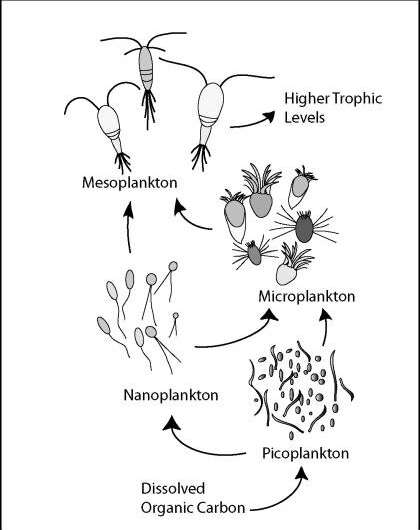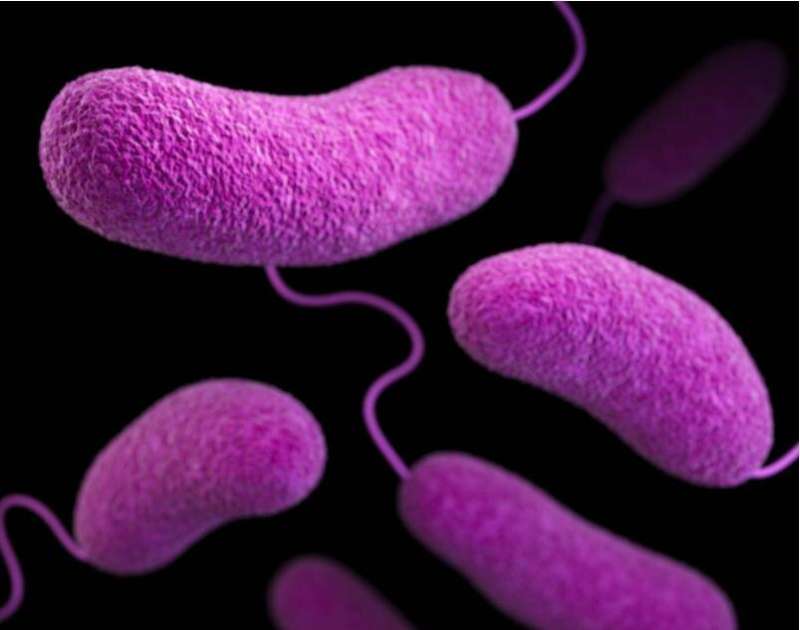The Earth’s oceans are home to huge numbers of bacteria. Credit: NASA
By and large, marine bacteria have a fairly simple existence – eat, divide, repeat. But the first step isn't always straightforward. There are lots of nutrients in the ocean, but there's no Uber Eats for microscopic organisms. They must find their food, and it's not always at arm's reach.
We've known for a long time that some bacteria are capable of tracking down food through a combination of swimming and chemical detection, but until now we haven't known just how good they are at it.
An international team, led by Dr. Douglas Brumley from the University of Melbourne and Dr. Francesco Carrara from ETH Zürich, has observed and modelled 'chemotaxis' in bacteria and found that a common marine bacterium can find sources of nutrients close to the theoretical limit of detection.
"The food sources for bacteria in the ocean are patchy and dynamic, just like for human populations," says Dr. Brumley, Lecturer in Applied Mathematics in the School of Mathematics and Statistics.
"Humans navigate towards cafes, restaurants and supermarkets in order to find food. If you're not in a location where there is food, you don't get the benefit. You have to be able to move towards it."
Bacteria are crucial to ocean ecosystems and are the base of the marine food web. They suck up nutrients that are floating around in the water and are then eaten by larger planktonic organisms, who are in turn gobbled up by crustaceans and small fish, and so forth.
Bacteria make up a large component of picoplankton, which is the base of the marine food web. Credit: Wikimedia
"Bacteria are extremely important for marine nutrient cycles, but a major challenge is figuring out just how much they eat. It's not an easy question to answer, but our results point to a way forward," says study co-author Dr. Andrew Hein, from University of California Santa Cruz.
A food source can suddenly appear out of nowhere, for example when a microalgae cell breaks apart, releasing its nutrient-rich contents into the water. This leaves a high concentration of nutrients near the source and a low concentration further away – what the scientists call a concentration gradient.
Some bacteria have evolved both the ability to swim using hair-like flagella, and the ability to sense a chemical gradient.
"Many bacteria perform a process called chemotaxis which enables them to detect a whiff of a chemical cue, and move towards the source of that compound," says Dr. Brumley.
"The process of chemotaxis is present in a range of environments, even bacteria in your mouth respond to the chemicals in your teeth and your plaque and can navigate towards those."
Chemotaxis has been extensively studied in the lab – the most well-known and well-studied enteric bacterium, E. coli, is chemotactic – but Dr. Brumley says that in many cases studies do not accurately replicate what happens in the ocean.
There is no food delivery service for bacteria in the ocean. Credit: Wikimedia/Franklin Haijnen
"It is routinely assumed that a nutrient gradient is either steady or very strong, so it's easy for bacteria to navigate. But in a range of realistic conditions the gradients are very, very weak, almost flat, so they are difficult or impossible to detect," he says.
"Not many people have asked the question: How far do you need to be from that little food package to actually be able to detect it and respond to it?" says Dr. Brumley.
"It's tremendously important to characterise the bacterial response, particularly in the ocean where nutrients are typically very sparse."
Dr. Brumley and colleagues from ETH Zürich, University of California Santa Cruz, University of Tsukuba and Princeton University ran experiments observing and modelling how bacteria react to the sudden appearance of a nutrient source, and published their results in the journal PNAS.
They paired an abundant marine bacterium, Vibrio ordalii, with a common amino acid and potent chemical attractant, glutamate.
"This represents an excellent model system for exploring the physical and chemical responses of marine bacteria to ephemeral nutrient patches," says Dr. Carrara, a researcher in the group of Professor Roman Stocker at ETH Zürich.
Vibrio bacteria with their characteristic curved rod-like shape and single swimming flagellum are common throughout the oceans and many other habitats. Pictured is a computer-generated image of Vibrio parahaemolyticus, which lives in coastal waters and is a cause of gastrointestinal disease in humans. Credit: CDC/James Archer
When the experiment begins, the bacteria are surrounded by glutamate, but it's invisible to them, because the glutamate is attached to another molecule in what is called a 'caged form'. A microscopic targeted pulse of light releases the glutamate in a single spot in the experimental chamber, and then the race is on.
"It's like you are walking through a supermarket in the dark. You've got no idea of the abundance of food around you. Suddenly someone switches on a spotlight that shines very precisely on a certain shelf," says Dr. Carrara.
The researchers record the bacteria with a video camera attached to a microscope and then use image processing to track the movement of individual bacterial cells. In a single experiment they will collect up to 1 million trajectories.
Dr. Brumley explains that the bacteria find nutrients by playing the children's game 'Hot and Cold'.
"They swim along, and if they detect that the gradient is positive and they are receiving more nutrients, then they keep going. On the other hand, if they detect that things are getting worse, that they are seeing a lower concentration of the chemical that they are interested in, they head off in a new, random direction."
This process is slightly inefficient because the bacteria have very short memories, but it is easy for the bacteria to hone in on a very strong nutrient gradient. When the gradient is weak, however, the bacteria can misread the gradient and head off in the wrong direction.
Image processing allows researchers to track individual bacteria, which over time converge on the nutrient source in the centre of the frame. Credit: University of Melbourne and ETH Zürich.
The research team created mathematical models to calculate the precision with which these bacteria can find a nutrient source. And it turns out this particular bacterium is very good at detecting nutrients.
"Even with all of the sources of noise, including molecule signalling noise in the cell, the behavioural noise and the flagella, the cells operate relatively close to the fundamental theoretical limit," says Dr. Brumley.
Professor Stocker says that it has long been known that marine bacteria are very good swimmers.
"They typically swim at 50 to 100 body lengths per second, which is—in relative terms—much faster than the world record in the 100 metre sprint," he says.
"Our work shows that they are not only fast, they are also very precise in how they use motility to find the often scarce nutrient sources in the ocean."
More information: Andrew M. Hein et al. Natural search algorithms as a bridge between organisms, evolution, and ecology, Proceedings of the National Academy of Sciences (2016). DOI: 10.1073/pnas.1606195113
Journal information: Proceedings of the National Academy of Sciences
Provided by University of Melbourne



























